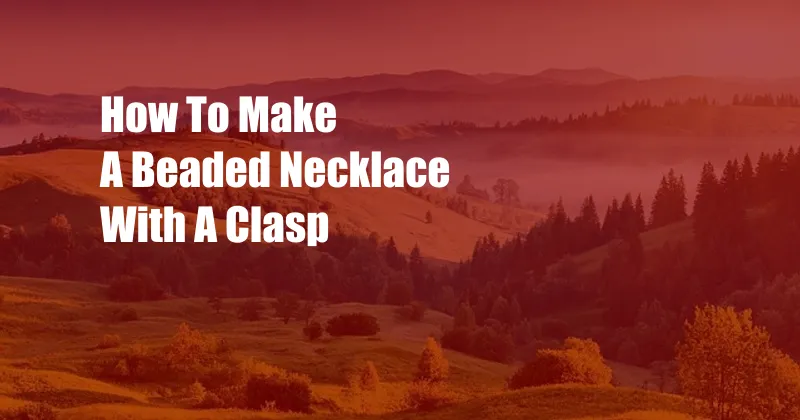
How to Make a Beaded Necklace with a Clasp: A Comprehensive Guide
Introduction
For those of us who appreciate the beauty of handmade jewelry, creating a beaded necklace is an exceptionally rewarding endeavor. The intricate play of beads, the symphony of colors, and the sophisticated elegance of a clasp come together to form a piece that is as unique as the wearer. In this article, we will embark on a journey to unveil the art of crafting a beaded necklace with a clasp, armed with detailed instructions and expert insights.
In this article, we will learn:
- What is a beaded necklace?
- The types of beads and clasps available
- How to choose the right beads and clasp for your necklace
- How to string the beads
- How to attach the clasp
The Art of Beading
Beading, the age-old craft of threading beads onto a string or wire, dates back to the Neolithic era. From the humble beginnings of using natural materials like shells and bones, beading has evolved into a diverse art form with countless variations of beads and techniques. In the following paragraphs, we will delve into the world of beads, clasps, and the intricate process of creating a beaded necklace.
Beads: A World of Variety
The world of beads is a vibrant tapestry of materials, shapes, sizes, and colors. From the shimmer of glass to the organic warmth of wood, from the earthy tones of stone to the iridescent glow of crystal, the choice of beads is as vast as the imagination. Each type of bead possesses a unique character and aesthetic, offering endless possibilities for personalized jewelry creation.
Clasps: The Finishing Touch
The clasp is an essential component of a beaded necklace, serving as both a functional and decorative element. It securely holds the necklace together while adding a touch of sophistication. Clasps come in various styles, including lobster claws, toggle clasps, and magnetic clasps, each with its own advantages and aesthetic appeal. Choosing the right clasp for your necklace requires careful consideration of the bead style and the desired overall look.
The Stringing Process: Uniting the Elements
With the beads and clasp selected, the next step involves stringing them together. This seemingly simple task demands precision and attention to detail to ensure a durable and aesthetically pleasing final product. The type of stringing material, such as thread, wire, or elastic cord, should complement the weight and size of the beads. Proper stringing techniques, including the use of knots or crimps, ensure the security and longevity of the necklace.
The Clasp Attachment: A Secure Connection
The final stage of creating a beaded necklace is attaching the clasp. This crucial step requires precision and care to ensure a seamless transition between the clasp and the beaded strand. The method of attachment depends on the type of clasp used. Some clasps, such as lobster claws, require the use of jump rings to connect them to the necklace. Others, like toggle clasps, may be attached directly to the beaded strand.
Expert Advice: Enhancing Your Craft
To elevate your beading experience, we have consulted with seasoned jewelry makers and gathered valuable insights. These tips and expert advice will help you refine your technique and create stunning beaded necklaces that will garner admiration.
- Experiment with Different Bead Combinations: Explore the endless possibilities of bead combinations to create necklaces with unique patterns and textures.
- Consider Bead Size and Shape: The size and shape of the beads influence the overall look and feel of the necklace. Experiment with different combinations to achieve the desired effect.
- Pay Attention to Color Theory: Understand the principles of color theory to create necklaces with harmonious or contrasting color palettes.
- Use a Clasp that Complements the Beads: Choose a clasp that complements the style and weight of the beads to ensure a cohesive and balanced design.
Frequently Asked Questions: Unraveling Beading Mysteries
To address common queries related to beaded necklaces, we have compiled a comprehensive FAQ section. These questions and answers will provide you with further clarity and empower you to create exceptional jewelry pieces.
Q: What is the best type of thread for stringing beads?
A: The choice of thread depends on the weight and size of the beads. Nylon thread is a popular option for its strength and durability.
Q: How do I prevent the beads from falling off the string?
A: Use knots or crimps to secure the beads in place. Knots can be tied between each bead, while crimps are small metal tubes that are crimped onto the string to hold the beads in place.
Q: What is the difference between a lobster claw clasp and a toggle clasp?
A: A lobster claw clasp has a spring-loaded mechanism that opens and closes, while a toggle clasp has two bars that slide into each other to secure the necklace.
Conclusion
Creating a beaded necklace with a clasp is a rewarding and versatile craft that allows you to express your creativity and style. With the guidance provided in this comprehensive article, you are now equipped with the knowledge and skills to craft exquisite necklaces that will enhance your wardrobe and delight those around you.
Are you intrigued by the art of beading and eager to embark on your own jewelry-making journey? Share your enthusiasm and questions in the comments section below!